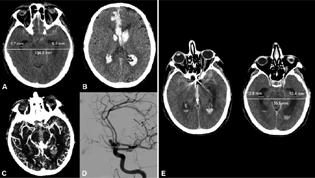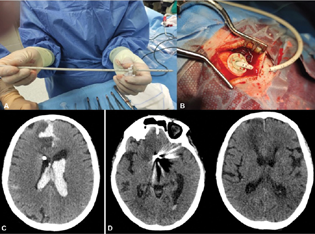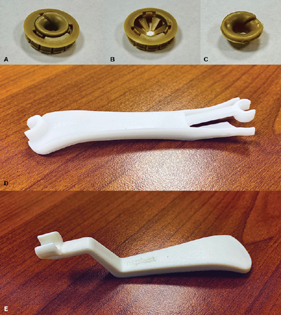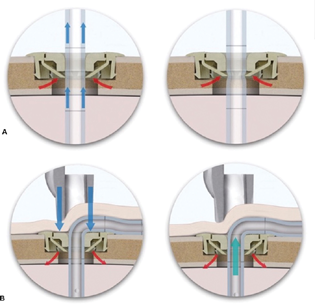Translate this page into:
“Catheter-Locking Device-Assisted” External Ventricular Drain Placement: A New Surgical Technique Preventing Intracranial Drain Displacement—Technical Note with Preliminary Single-Center Results
Anthony Kevin Scafa, MD Department of Neurological Sciences, “La Sapienza” University of Rome Rome 00161 Italy anthonykevin.scafa@uniroma1.it
This article was originally published by Thieme Medical and Scientific Publishers Pvt. Ltd. and was migrated to Scientific Scholar after the change of Publisher.
Abstract
Abstract
Background External ventricular drain (EVD) placement is frequently performed in neurosurgical patients to divert cerebrospinal fluid (CSF) and monitor intracranial pressure. The traditional practice is the tunneled EVD technique performed in the operating room. EVD insertion through a bolt in intensive care units has also been reported. We describe here the usage of a novel technique, the “catheter-locking device-assisted” EVD placement, reporting our preliminary, observational single-center results.
Methods From January to October 2021, 15 patients underwent a “catheter-locking device-assisted” EVD placement at our institute. For each of these patients, the following data were evaluated: (1) demographics, (2) etiology, (3) clinical presentation, (4) EVD complications, and (5) final clinical outcomes.
Results Median age of our population was 64 years, with a female/male ratio of 2:1. Average Glasgow Coma Scale score on admission was 8. Each patient maintained the drainage for an average time of 14 days. None of the patients suffered from postoperative intracerebral hemorrhage, CSF leakage, catheter migration, or discontinuation of the drainage system; none developed signs of infection. Nine patients required a permanent CSF diversion system. Outcome was good in 14 patients. One patient died for the underlying disease.
Conclusions The “catheter-locking device-assisted” EVD placement appears to be a safe and accurate alternative to both the standard tunneled and the bolt-assisted EVD insertion techniques. The use of this procedure may significantly reduce the incidence of the commonest EVD complications, though further investigation is required.
Keywords
complications
catheter-locking device
cranial bolt
external ventricular drain
hydrocephalus
Introduction
Insertion of an external ventricular drain (EVD) is surely one of the most common and most important lifesaving procedures in neurosurgical practice, being able to alleviate symptoms associated with hydrocephalus, monitor, and manage increased intracranial pressure (ICP), and to administer intrathecal drugs.
The standard practice worldwide is the tunneled EVD technique. EVD placement through a bolt in intensive care units has also been described.1
We herein describe the application of an innovative, Italian procedure, i.e., the “catheter-locking device-assisted” EVD technique, reporting our preliminary, observational single-center results.
The catheter-locking device is a recently developed tool, used to clamp ventricular drain catheters to prevent their own, undesirable dislocation. The “catheter-locking device-assisted” technique may be useful to reduce the incidence of the commonest EVD complications, in particular that of infections. We analyze here the technical nuances of the procedure, also presenting an illustrative case from our experience.
Methods
In the period between January and October 2021, 48 patients underwent EVD surgery for subacute or acute hydrocephalus at our institute (Neurosurgery, Department of Neurology and Psychiatry, “Sapienza” University of Rome). Among these, 15 patients received an EVD through a “catheter-locking device-assisted” technique (NTDRAIN system, ntplast advanced biomedical solutions), “study” group. For each of these patients the following data were collected and analyzed: (1) demographics, (2) etiology, (3) clinical presentation, (4) EVD complications, and (5) final clinical outcomes (the need for external to permanent internal shunt “conversion” was of course considered). Results regarding complications and final clinical outcomes were later compared with those of 105 patients in which a traditional, “nonassisted” tunneled EVD technique was performed between January 2020 and October 2021, “control” group.
Results
Between January and October 2021, 15 patients underwent an “assisted” EVD surgery (“study” group). Median age of these patients was 64 years (range 47–75 years). Female/male (F/M) ratio was 2:1. Regarding etiology: (1) 6 cases were associated with spontaneous nontraumatic intracranial hemorrhage (4 aneurysmal subarachnoid hemorrhages (aSAH), 2 “typical” hypertensive intracerebral hemorrhages (ICHs) with ventricular involvement), (2) 4 were due to obstruction from posterior cranial fossa neoplasms (3 cerebellar metastases, 1 brainstem high-grade glioma), (3) 1 resulted from cerebellar ischemic stroke, (4) 1 from aseptic meningitis, while (5) in 3 cases hydrocephalus was a complication of posterior cranial fossa surgery. Average Glasgow Come Scale score at presentation was 8. Each patient maintained the drainage for an average time of 14 days. None of the patients experienced ICH, cerebrospinal fluid (CSF) leakage, catheter migration, or discontinuation of the drainage system. None developed signs of infection during the period of observation. Wound revision was not required in neither case. Nine patients (60%) required a permanent CSF diversion system (ventriculoperitoneal shunt in each case). Overall outcome was good in 14 patients (93.3%), with clear improvement in sensorium. One patient (6.7%) died due to the underlying disease (brainstem high-grade glioma).
Between January and December 2020, 72 patients underwent a traditional, “nonassisted” EVD surgery. These patients, along with those treated in the same way between January and October 2021 (n = 33), made up our “control” group as for complications and final clinical outcomes. Catheter migration requiring reintervention was observed in 13 out of 105 patients (12.4%), after a mean time of 5 days: in 9 cases (69.2%) it was related to ward hygienic care, while in 4 cases (30.8%) it was due to intrahospital transport to the Radiology Department. Six patients (5.7%) developed signs of infection requiring antibiotic treatment (alone or associated with wound revision). A total of 62 patients (59%) required long-term CSF diversion via an internalized shunt system. Overall outcome was good in 88 patients (83.8%). In addition, 17 patients (16.2%) died due to the underlying disease or to the consequences of CSF infection (2 out of 6 patients).
Owing to the discrepancy in terms of sample size, it was not possible to perform a detailed statistical analysis: our data are indeed preliminary.
Illustrative Case
A 70-year-old man with a 20-year history of hypertension presented with sudden onset of severe headache, vomiting, and decreased conscious level. On admission, he was drowsy with a GCS score of 8 (E2V2M4). An emergency computed tomography (CT) scan of the head showed a considerable amount of hemorrhage in the subarachnoid space at the level of the basal cisterns, especially in the pre-chiasmatic area and, anteriorly, along the falx cerebri, with right frontal ICH and a large amount of hemoventricle; initial hydrocephalus was also detected (Fig. 1A, B). The CT-angiogram demonstrated an aneurysm of the anterior communicating artery, showing morphological abnormalities (Fig. 1C). Under general anesthesia with right transfemoral access, a complete angiographic study was immediately performed. The exam confirmed the presence of the aneurysm which showed an irregular, bilobed morphology, developing cranially and posterolaterally to the right; the A2 tracts of both the anterior cerebral arteries originated from its neck. The sac showed a transverse diameter of 6 mm and a height of 10 mm (Fig. 1D). The patient was diagnosed with aSAH with parenchymal and ventricular involvement (Hunt and Hess grade 4, WFNS [World Federation of Neurosurgical Societies] grade 4, Fisher grade 4) and nimodipine was started. Endovascular treatment (coiling with complete exclusion of the aneurysm) was the choice. Postprocedural CT scan showed no further bleedings but revealed additional enlargement of the supratentorial ventricular system (Fig. 1E). An EVD was therefore placed in the right frontal horn of the patient (NTDRAIN system was used in the operating room to avoid drain displacement) (Fig. 2A–C). The patient was transferred to the intensive care unit for multiparameter monitoring. Postoperative CT scans demonstrated gradual resolution of both the hemorrhage and the hydrocephalus. The drain was left in place for 2 weeks, while the patient progressively improved: he was alert, unable to speak since tracheostomized (though comprehension was preserved), and he could obey simple and complex commands with the right side of his body (the left side was paretic). Neither dislocation of the catheter nor CSF infection was observed. After 14 days, an EVD closure test was performed. This was well tolerated without recurrent symptoms of hydrocephalus or radiological evidence of enlarging ventricles. The drain was thus removed, and the patient sent for rehabilitation to a dedicated center. Postoperative day 30 brain CT scan is shown in Fig. 2D.

-
Fig. 1 Preoperative images. (A, B) Brain computed tomography (CT) scan showing subarachnoid hemorrhage in the basal cisterns and along the falx cerebri, with right frontal intracerebral hemorrhage and tetra-hemoventricle. Note in (A) the presence of ventricular dilation as demonstrated by a temporal ratio (TR), in the most “favorable” section, of (5.7 + 9.8) mm/134.8 mm = 0.1. TR was calculated as the ratio between the width of the temporal horns at the level of maximal convexity of the hippocampus and the maximum width of the inner table of the cranium at the same level (normal values ≤ 0.07). (C) Angio-CT and (D) brain angiography showing an AcoA aneurysm with irregular, bilobed morphology, developing cranially and postero-laterally to the right (transverse diameter: 6 mm; height: 10 mm). Postembolization images:
(E) On the left, coils within the sac without signs of further bleeding; on the right, worsening in ventricular dilation with a TR, in the most “favorable” section, of (12.8 + 13.4) mm/135.5 mm = 0.2 (normal values ≤ 0.07). AcoA, anterior communicating artery; CT, computed tomography.
Fig. 1 Preoperative images. (A, B) Brain computed tomography (CT) scan showing subarachnoid hemorrhage in the basal cisterns and along the falx cerebri, with right frontal intracerebral hemorrhage and tetra-hemoventricle. Note in (A) the presence of ventricular dilation as demonstrated by a temporal ratio (TR), in the most “favorable” section, of (5.7 + 9.8) mm/134.8 mm = 0.1. TR was calculated as the ratio between the width of the temporal horns at the level of maximal convexity of the hippocampus and the maximum width of the inner table of the cranium at the same level (normal values ≤ 0.07). (C) Angio-CT and (D) brain angiography showing an AcoA aneurysm with irregular, bilobed morphology, developing cranially and postero-laterally to the right (transverse diameter: 6 mm; height: 10 mm). Postembolization images: (E) On the left, coils within the sac without signs of further bleeding; on the right, worsening in ventricular dilation with a TR, in the most “favorable” section, of (12.8 + 13.4) mm/135.5 mm = 0.2 (normal values ≤ 0.07). AcoA, anterior communicating artery; CT, computed tomography.

-
Fig. 2 Intraoperative images.
(A) Preassembled catheter-locking device applied to the drain, serving as a “depth reference.” (B) Final result with the catheter-locking device implanted in the burr hole, locking the drain. Postoperative images:
(C) Postoperative day 1 brain CT scan showing the correct positioning of the EVD with the tip inside the frontal horn of the right ventricle. (D) Postoperative day 30 brain CT scan showing resolution of both the hemorrhage (minimal residual hemoventricle) and the hydrocephalus (despite EVD removal). CT, computed tomography; EVD, external ventricular drain.
Fig. 2 Intraoperative images. (A) Preassembled catheter-locking device applied to the drain, serving as a “depth reference.” (B) Final result with the catheter-locking device implanted in the burr hole, locking the drain. Postoperative images: (C) Postoperative day 1 brain CT scan showing the correct positioning of the EVD with the tip inside the frontal horn of the right ventricle. (D) Postoperative day 30 brain CT scan showing resolution of both the hemorrhage (minimal residual hemoventricle) and the hydrocephalus (despite EVD removal). CT, computed tomography; EVD, external ventricular drain.
Surgical Technique
Equipment
The “catheter-locking device-assisted” EVD placement technique involves the use of three main instruments:
-
A catheter-locking device (Fig. 3A) consisting of:
-
A disposable polymer applier forceps (Fig. 3D) for the catheter-locking device implantation; the instrument is made up of two halves: (1) the anterior half consists of a “crown-holder” with a “lever” for the compression of the insert, while the (2) posterior one (similar to the activator, see below) is designed for the adjustment of the catheter depth through the craniostomy hole in the operating room.
-
A disposable polymer activator (Fig. 3E) for transcutaneous withdrawal of the catheter.

-
Fig. 3 Equipment. (A) Preassembled catheter-locking device. (B)
Catheter-locking device: external crown. (C)
Catheter-locking device: internal insert. (D) Disposable applier. Note the structure of the instrument, made up of two halves: an anterior half (on the right) consisting of a “crown-holder” with a “lever” for the insert compression of the insert, and a posterior one (on the left) designed for the adjustment of the catheter depth through the craniostomy hole in the operating room. (E) Disposable activator. See the text for usage details.
Fig. 3 Equipment. (A) Preassembled catheter-locking device. (B) Catheter-locking device: external crown. (C) Catheter-locking device: internal insert. (D) Disposable applier. Note the structure of the instrument, made up of two halves: an anterior half (on the right) consisting of a “crown-holder” with a “lever” for the insert compression of the insert, and a posterior one (on the left) designed for the adjustment of the catheter depth through the craniostomy hole in the operating room. (E) Disposable activator. See the text for usage details.
Procedure
A skin flap (centered on the standard Kocher's point) must be made through an incision in a curvilinear fashion. Linear incisions are not recommended (see below). It is of course important to avoid drilling the hole underneath the line of the incision. With the aid of the “lever” on the anterior half of the disposable applier already prefitted with the catheter-locking device, a compression on the insert is made to open the tabs of the crown, thus enabling the “down-to-top” insertion of the catheter into the insert itself. We advise to position the catheter-locking device at 6/6.25 cm from the catheter tip (based on preoperative CT scan) to reach the ventricle at the needed depth. At approximately 4 cm of depth (based on preoperative CT scan), the stylet of the catheter is removed, and the crown of the device is placed in the craniostomy hole with slight finger pressure. The handle of the applier (posterior half) can also be used to modify the depth of the catheter by pressing more or less on the insert, releasing or tightening of the catheter. At the end of the procedure, the applier is detached, the tabs lock the catheter (Fig. 4A), and it is possible to proceed with the tunneling phase and with the wound closure.

-
Fig. 4
(A) Locking mechanism. These images show the attempt to move the catheter vertically which causes the flaps to close: in this way the catheter is actively maintained in the correct position chosen by the operator. (B)
Catheter removal mechanism: These images show the catheter removal procedure. By acting with the disposable activator on the insert inside the crown, the retention flaps open and it is thus possible to remove the catheter under the skin.
Fig. 4 (A) Locking mechanism. These images show the attempt to move the catheter vertically which causes the flaps to close: in this way the catheter is actively maintained in the correct position chosen by the operator. (B) Catheter removal mechanism: These images show the catheter removal procedure. By acting with the disposable activator on the insert inside the crown, the retention flaps open and it is thus possible to remove the catheter under the skin.
Should it be necessary to replace the catheter, it is possible to remove the catheter-locking device through a Penfield dissector or using the mandrel with which the tunneling phase is performed by inserting it into the burr hole (not the sharp part, but the “back” of the instrument).
When removal of the catheter is needed, the surgeon must palpate the skin flap to recognize the catheter under the skin. By means of the disposable activator, positioned where the catheter emerges from the hole, an orthogonal compression is made on the underlying insert (linear incisions are not used since they may reopen in case of recent surgery). This maneuver will allow the flexible tabs to open with subsequent “discharge” of the catheter (Fig. 4B). The catheter-locking device remains in the site of insertion, carrying on its “aesthetic” role.
Special Considerations
The instrumentation employed for our research (NTDRAIN system, ntplast advanced biomedical solutions) is suitable to lock catheters with an external diameter of 3.3 or 3.0 mm and can be used in case of craniostomy holes made through a 14 mm drill only. It must not be implanted in patients under the age of 16 (owing to a different skull bone thickness in the pediatric population), and in patients who have shown signs of allergy to polyether ether ketone (PEEK). The implanted device is radiolucent (since made in PEEK), and it does not cause radiological artifacts. Furthermore, it is magnetic resonance imaging-compatible.
Discussion
EVD is one of the most frequently performed procedures in neurosurgery, being lifesaving in case of life-threatening conditions due to acutely increased ICP.
The standard practice worldwide is the tunneled EVD technique,1 performed in the operating theater by freehand technique using surface landmarks. The right frontal lobe is the preferred entry site, given its nondominance in most patients. Under local anesthesia, the skin is incised, and the periosteum dissected away from the calvarium. A burr hole is placed at Kocher's point (diameter 14–17 mm) and the skull penetrated in the trajectory desired for ventricular cannulation: toward the medial canthus of the ipsilateral eye on the coronal plane and a point approximately 1 cm anterior to the tragus on the sagittal plane. The meningeal coverings are cauterized and pierced with a scalpel, before introducing the drain with its stylet to a depth of approximately 5 cm. The stylet is then removed, and the catheter advanced for another 1 cm within the ventricle to reach the foramen of Monro. The distal part of the drain is in the end tunneled under the skin, secured, and connected to an external drainage system.
Though fundamental, this procedure is, of course, not free from complications. Procedurally induced ICH and inadvertent placement are reported in 10 to 40% of cases.2 Dislodgement, discontinuation of the drainage system, CSF leakage, and, most significantly, infection (which can be complicated by ventriculitis, meningitis, or brain abscess) are even more frequent.1 3 We believe that the use of the previously described technique may significantly reduce their incidence.
The “catheter-locking device-assisted” EVD placement permits indeed:
-
Not to lose the preoperatively established depth reference on the catheter, allowing for the correct positioning of the same.
-
To “block” the catheter preventing its own dislocation (once positioned).
-
To close the bone breach avoiding both CSF leakage and permanent aesthetic damage.
We ultimately suppose a potential, important role for this technique upon infection control. Infection is the commonest and most dreaded EVD complication since its first description by Claude-Nicolas Le Cat in 1744.4 In 1881, Carl Wernicke performed the inaugural “sterile” ventricular puncture and EVD,4 but the first closed system for CSF drainage was described by Ingraham and Campbell in 1941.5 With the introduction of subcutaneous tunneling by Saunders in 1979, infection rate decreased even more.1 Antibiotic- and silver-impregnated catheters, introduced in 2003 and in 2010 respectively, were similarly designed for this purpose.6 7 EVD-related infection (ERI) has a reported rate in the current literature between 1 and 45%, depending on how ERI is defined.1 Duration of EVD placement, mobility of the catheter, CSF leakage around the catheter, frequency of sampling, length of hospital stay, and concurrent infections in other systems were recognized as the most important predisposing factors.1 3 By avoiding drain displacement, CSF leakage, and the persistence of a bone gap in the site of entry, the use of a catheter-locking device could be a valid support to significantly reduce the incidence of infections. As previously mentioned, another procedure, i.e., the bolt-connected EVD technique (Bergdal et al, 2013),8 has been proposed as a useful tool for the same objective. This is performed through a 0.5-cm linear incision at Kocher's point. A twist drill (diameter 2.7 mm) is used to enter the skull, and a perforator is employed to sharply perforate the dura mater. The ventricular catheter—secured with a cranial bolt—is then inserted through the burr hole, and the bolt screwed into the burr hole itself.1 Contrary to expectations, however, no significant difference in superficial infection or ventriculitis rates compared with standard, tunneled EVDs, was found in the works by Asaad and Bjarkam, Jensen et al, and Roach et al.1 9 10 In our opinion, however, the “catheter-locking device-assisted” EVD placement technique could be superior to the bold-connected EVD one as it seals the skull breach in a permanent way, acting as a sort of “shield” against direct spread of microbes from the skin (besides preventing aesthetic damage).
The potential decrease in the incidence of the aforementioned complications could also lead to a reduction of any additional costs related to them.
The results shown here are of course preliminary since our aim was to describe the nuances of this new technique. Further investigation is being performed to prove our hypotheses.
Conclusions
The “catheter-locking device-assisted” EVD placement seems to be a safe and effective substitute for both the standard tunneled and the bolt-assisted EVD insertion techniques. The use of this procedure may considerably reduce the incidence of the commonest EVD complications, in particular that of infections, also leading to a reduction of any supplementary costs related to them. Further investigation is, however, required.
Conflict of Interest
None declared.
Funding None.
References
- The Aalborg Bolt-Connected Drain (ABCD) study: a prospective comparison of tunnelled and bolt-connected external ventricular drains. Acta Neurochir (Wien). 2019;161(1):33-39.
- [Google Scholar]
- Guided (VENTRI-GUIDE) versus freehand ventriculostomy: study protocol for a randomized controlled trial. Trials. 2014;15:478.
- [Google Scholar]
- External ventricular drain infections: risk factors and outcome. Interdiscip Perspect Infect Dis. 2014;2014:708531.
- [Google Scholar]
- An apparatus for closed drain- age of the ventricular system. Ann Surg. 1941;114:1096-1098.
- [Google Scholar]
- Efficacy of silver-bearing external ventricular drainage catheters: a retrospective analysis. J Neurosurg. 2010;112(4):840-846.
- [Google Scholar]
- Efficacy of antimicrobial-impregnated external ventricular drain catheters: a prospective, randomized, controlled trial. J Neurosurg. 2003;98(4):725-730.
- [Google Scholar]
- Accuracy of tunnelated vs. bolt-connected external ventricular drains. Clin Neurol Neurosurg. 2013;115(10):1972-1975.
- [Google Scholar]
- Fewer complications with bolt-connected than tunneled external ventricular drainage. Acta Neurochir (Wien). 2016;158(8):1491-1494.
- [Google Scholar]
- Safety, accuracy, and cost effectiveness of bedside bolt external ventricular drains (EVDs) in comparison with tunneled EVDs inserted in theaters. World Neurosurg. 2019;125:e473-e478.
- [Google Scholar]







